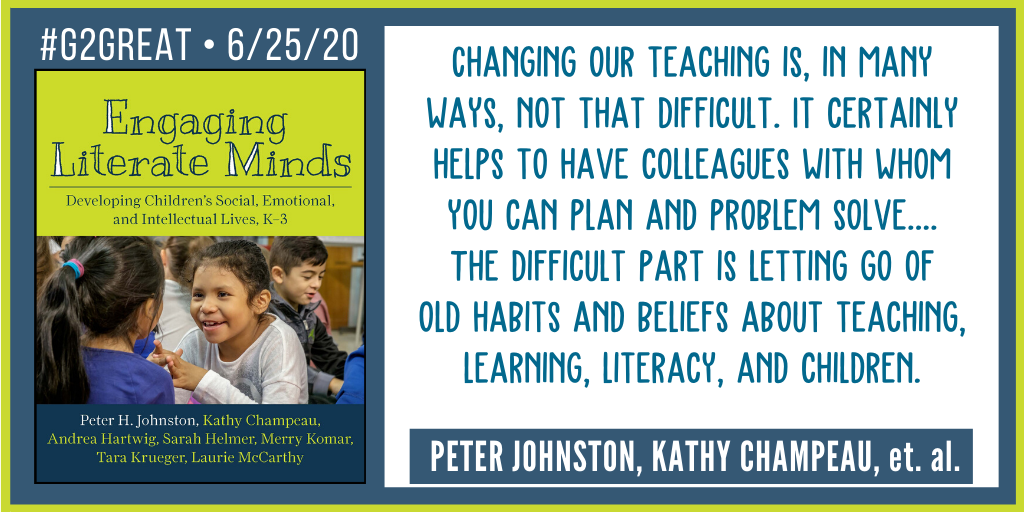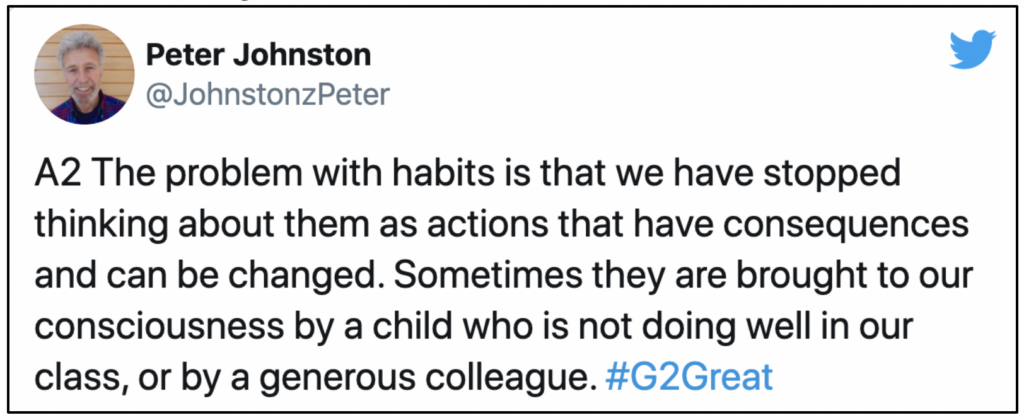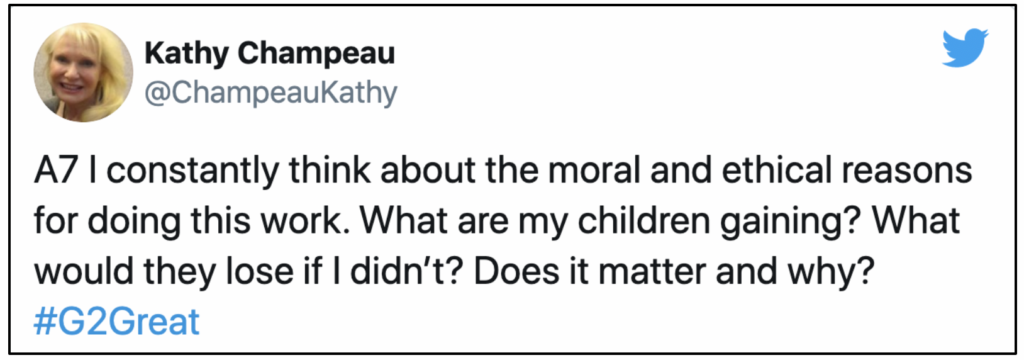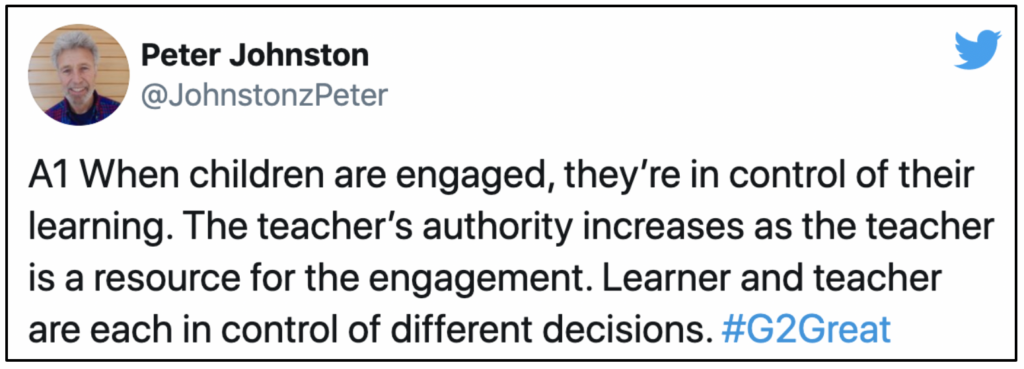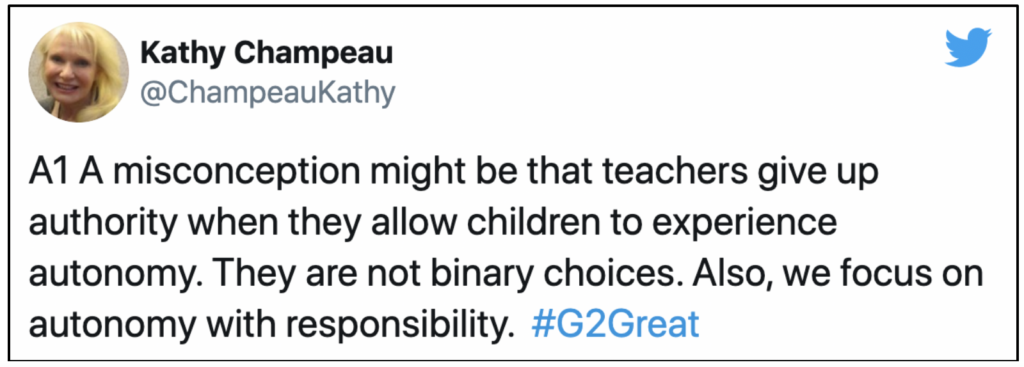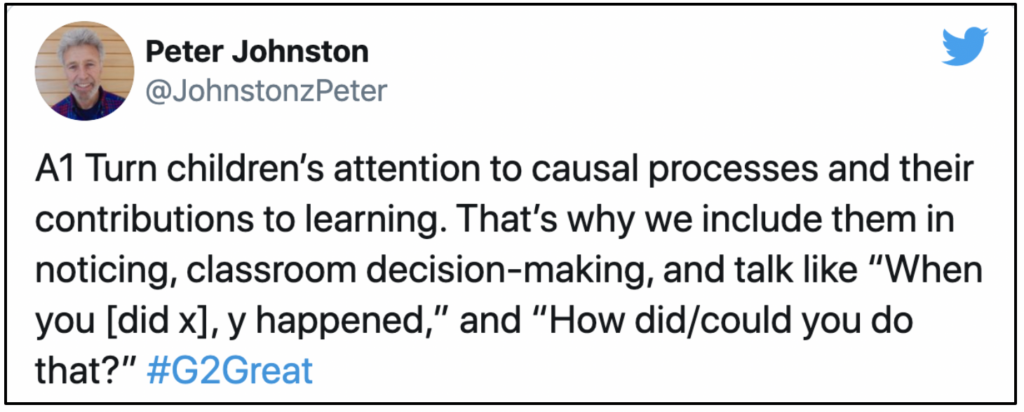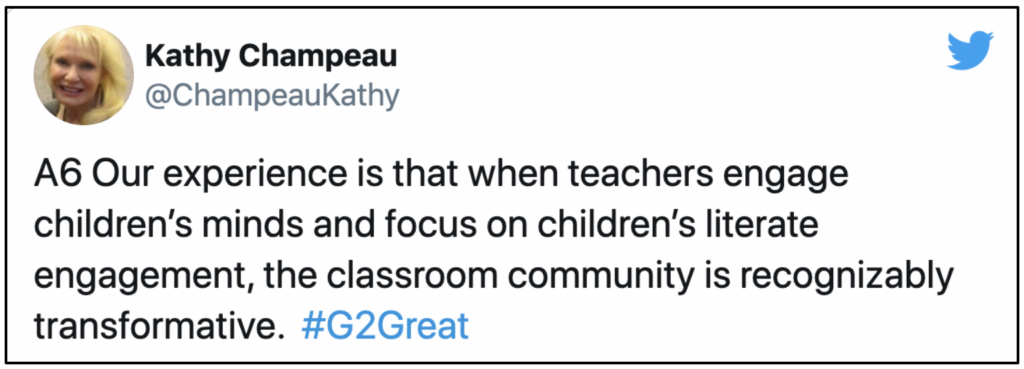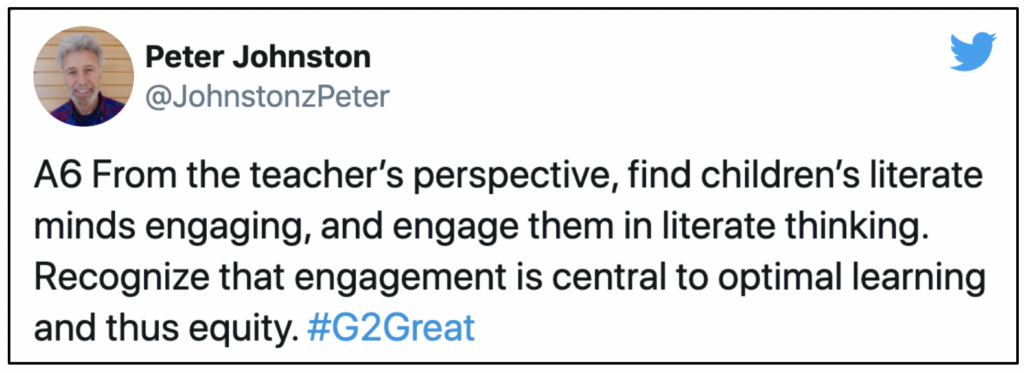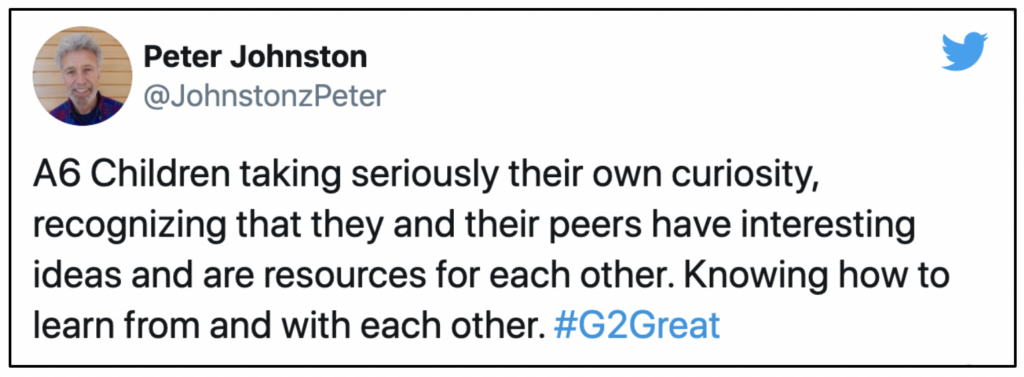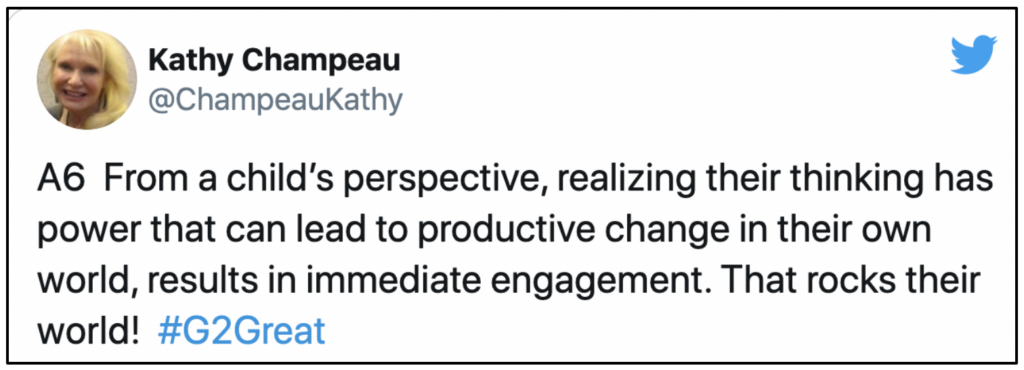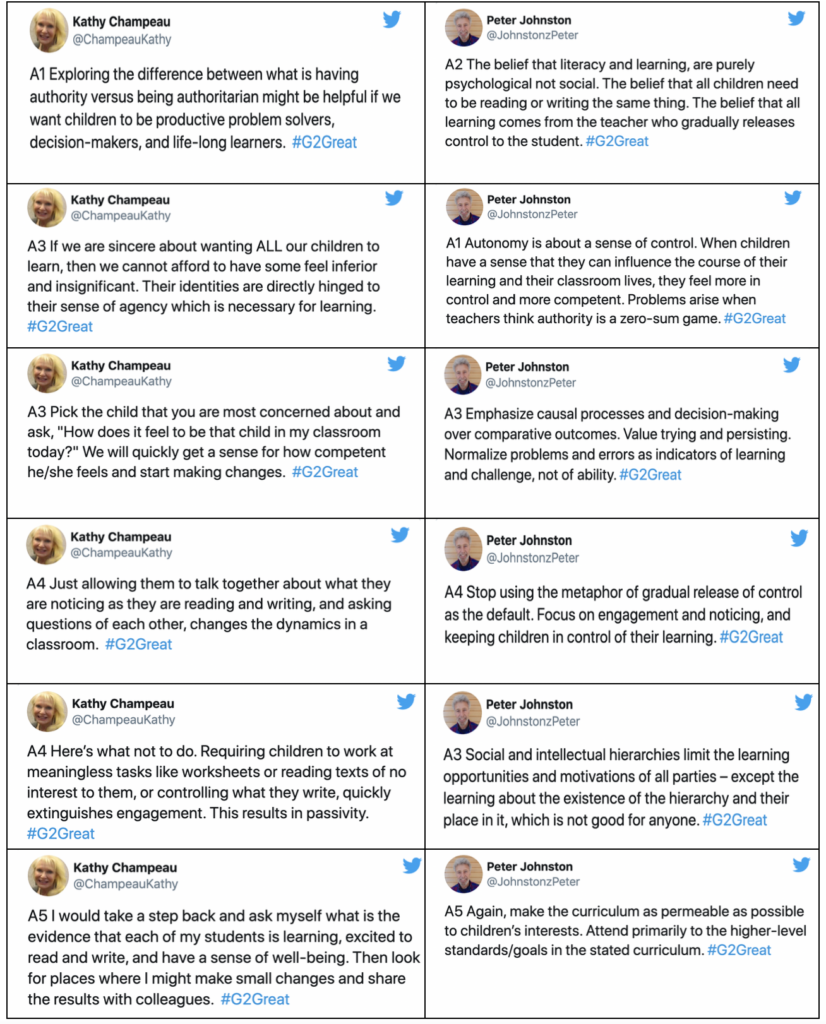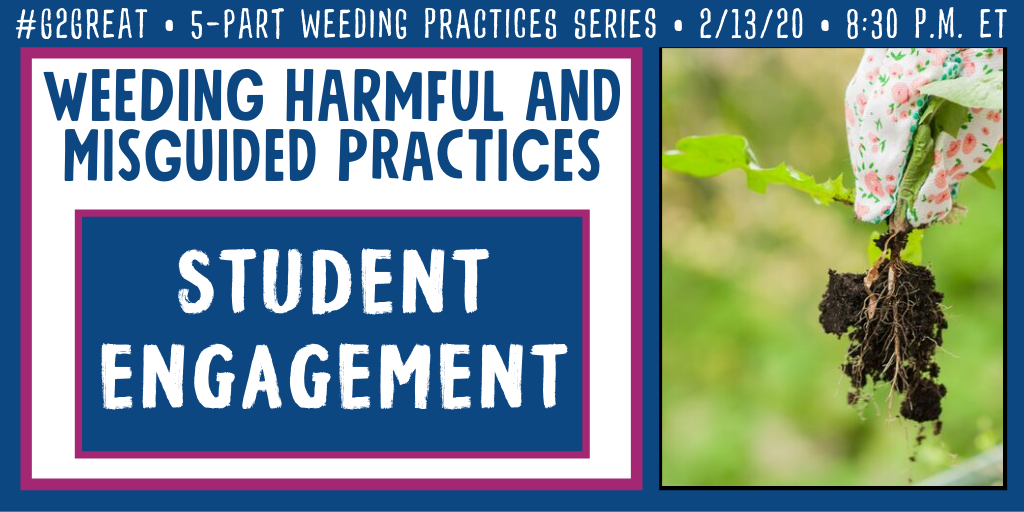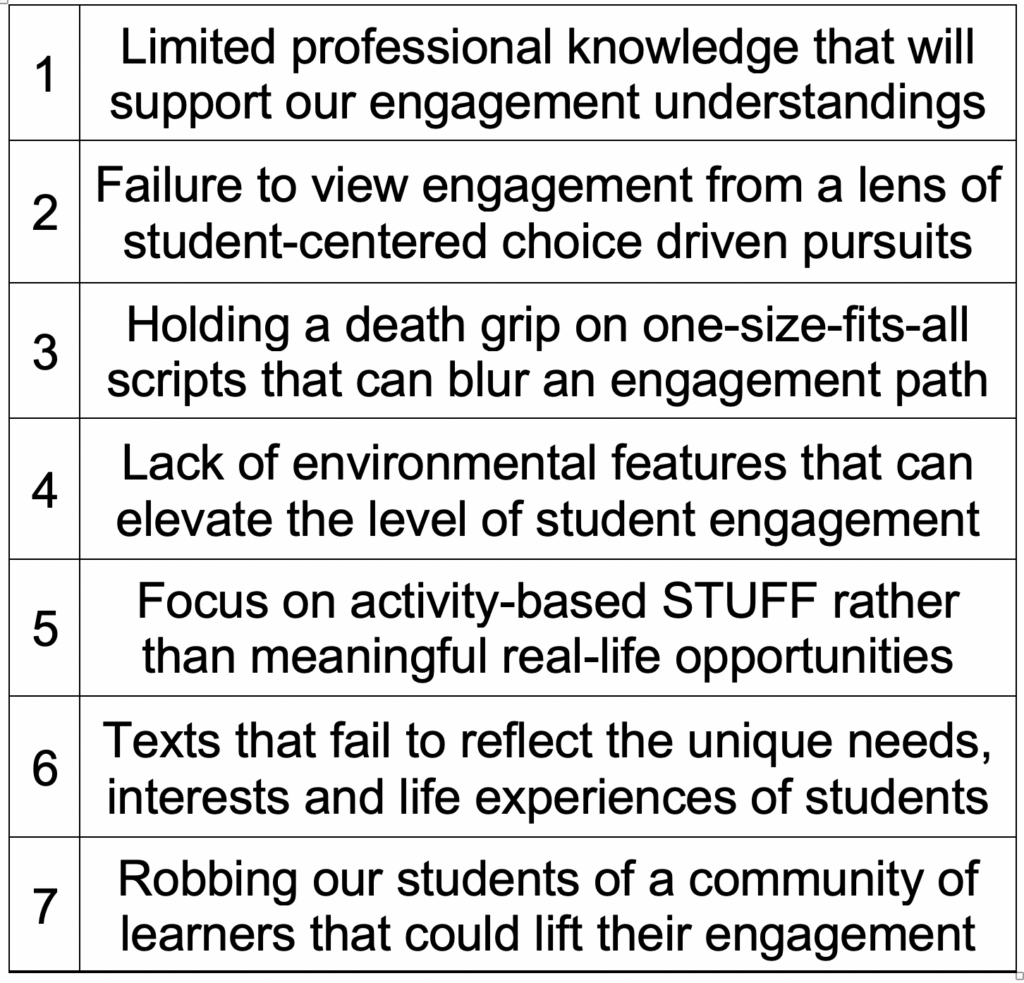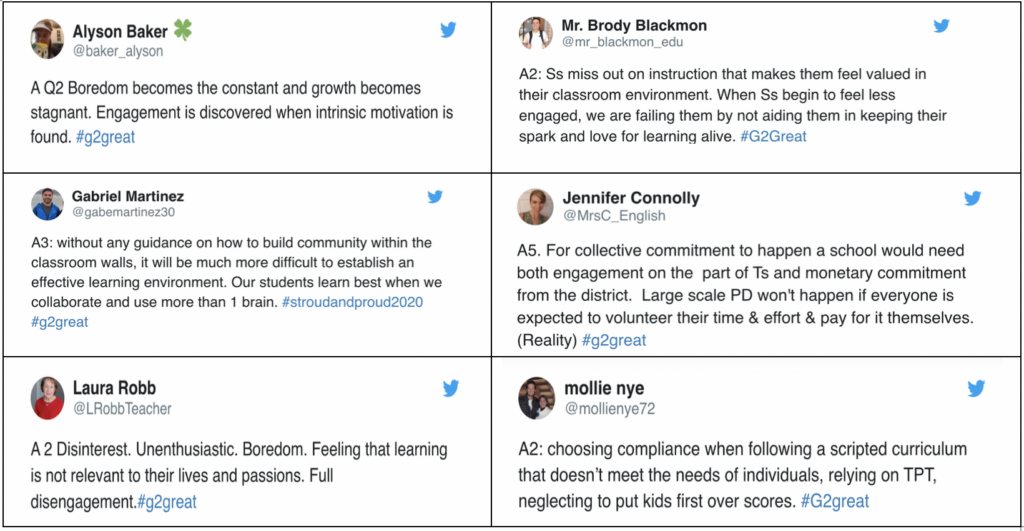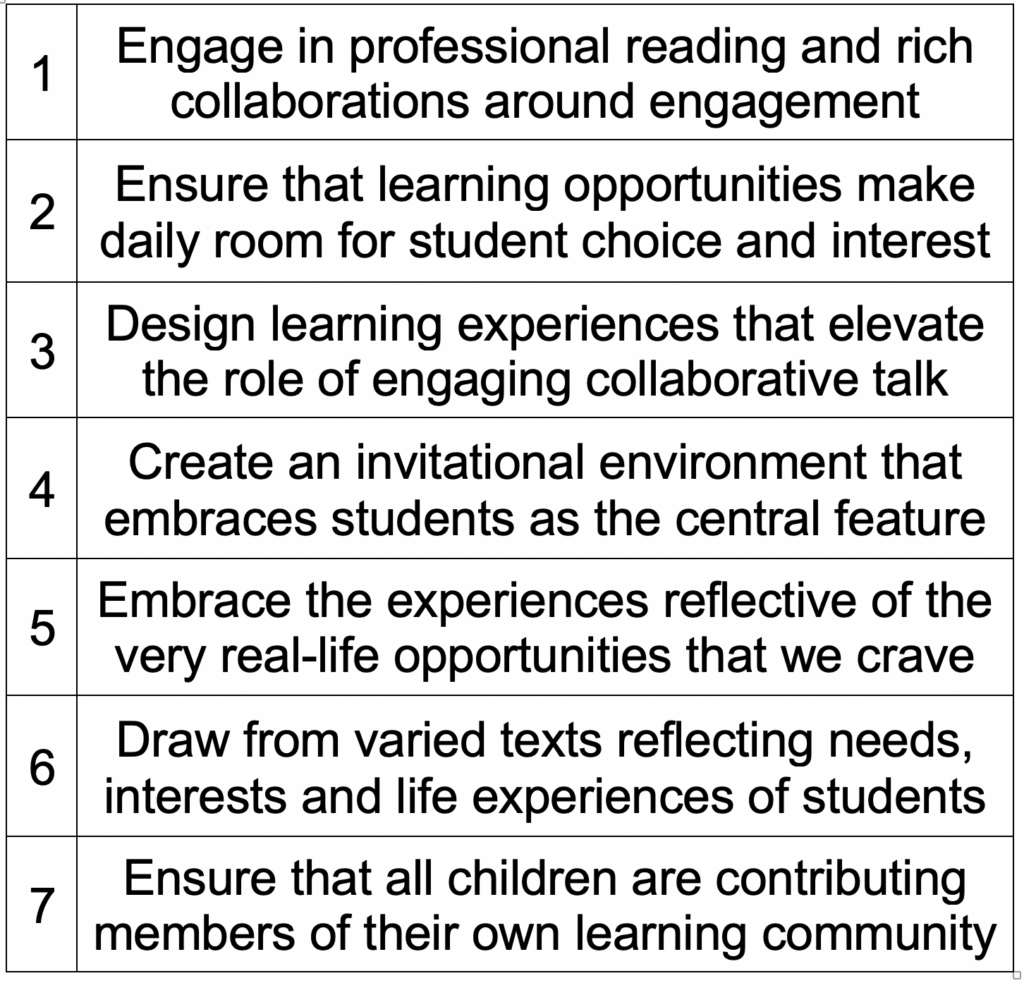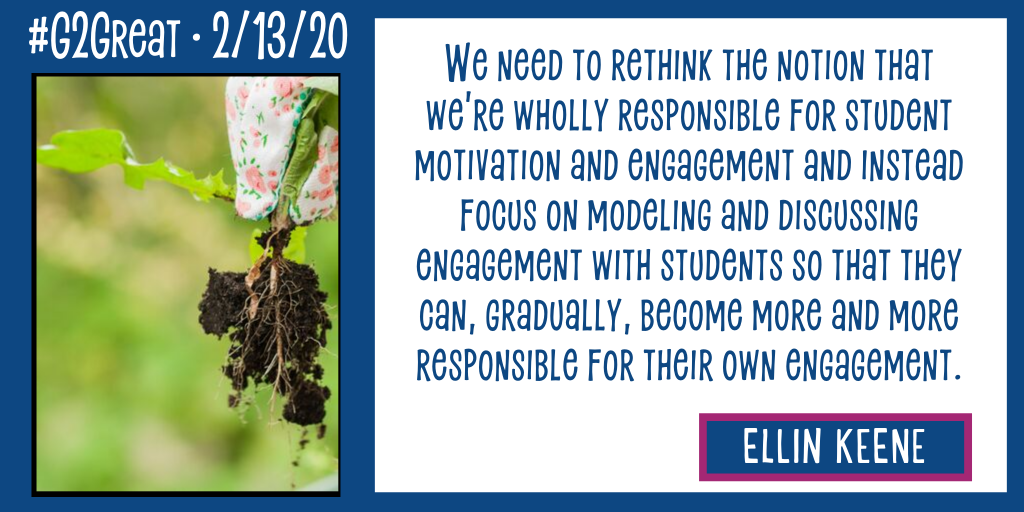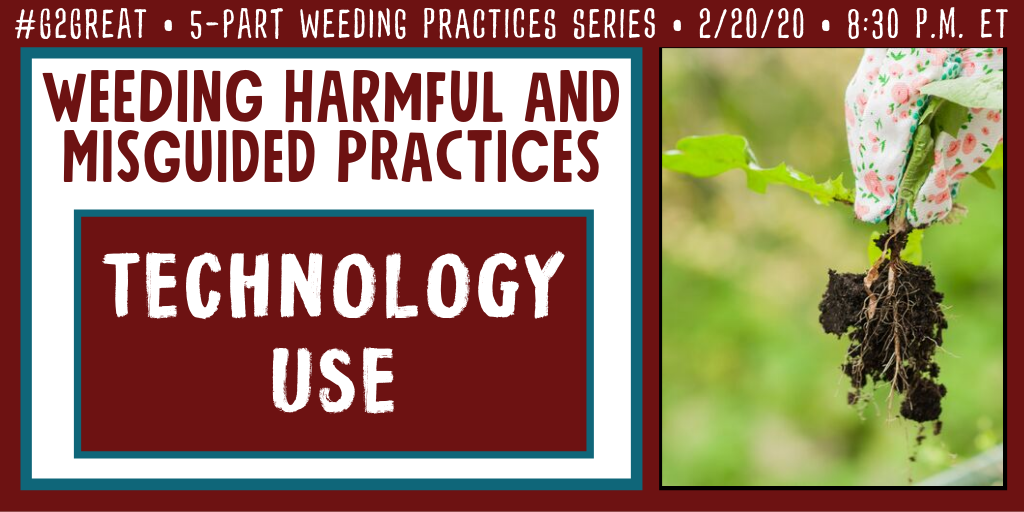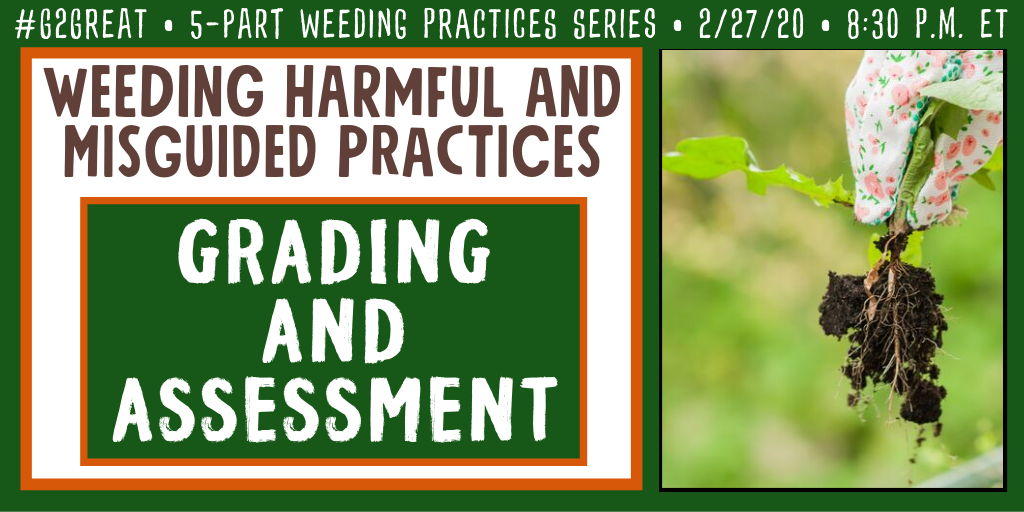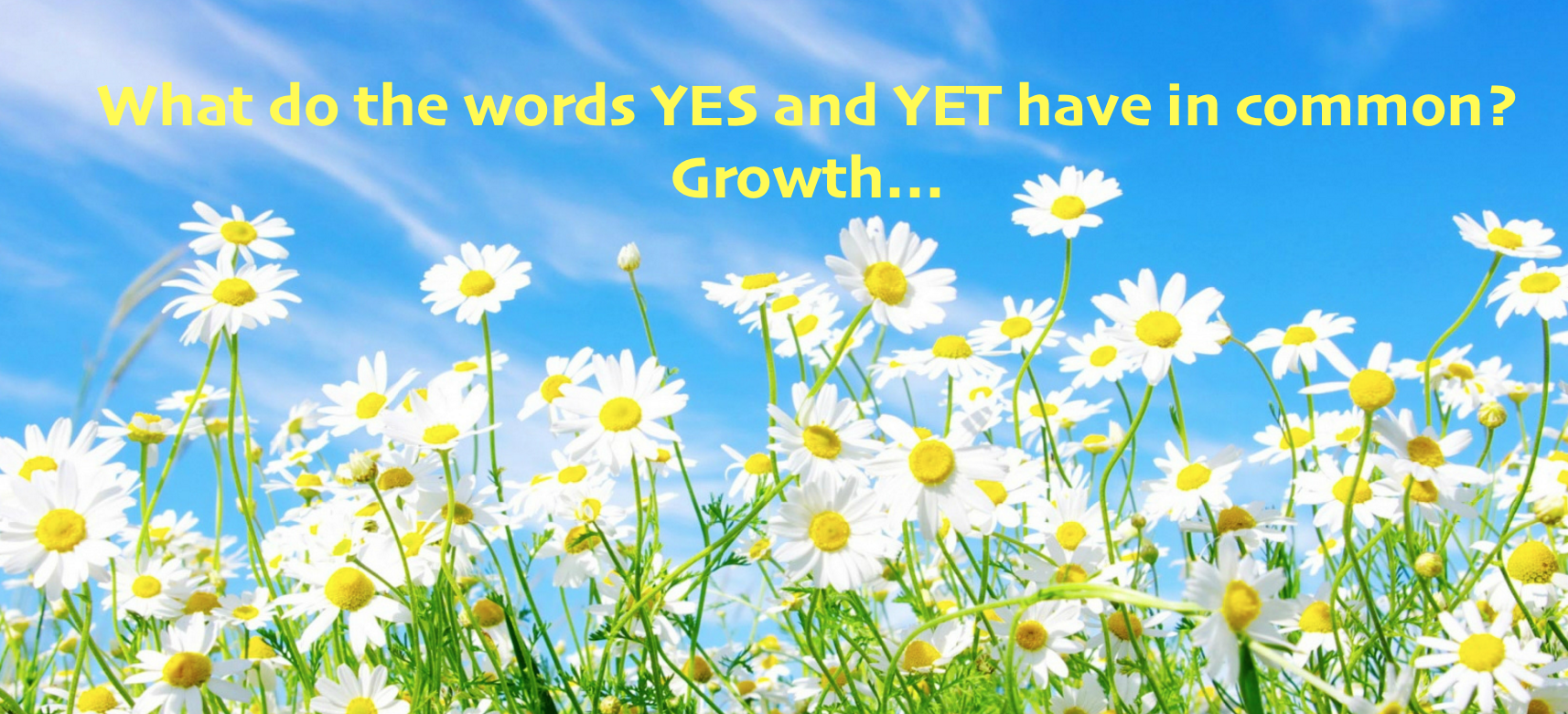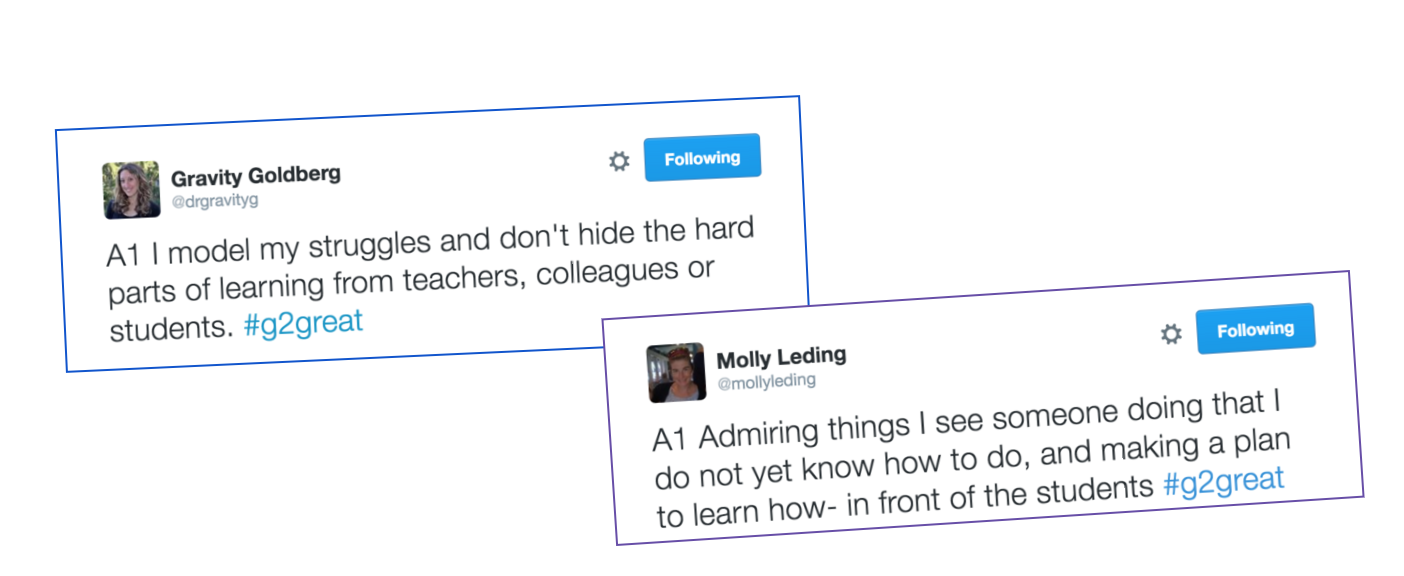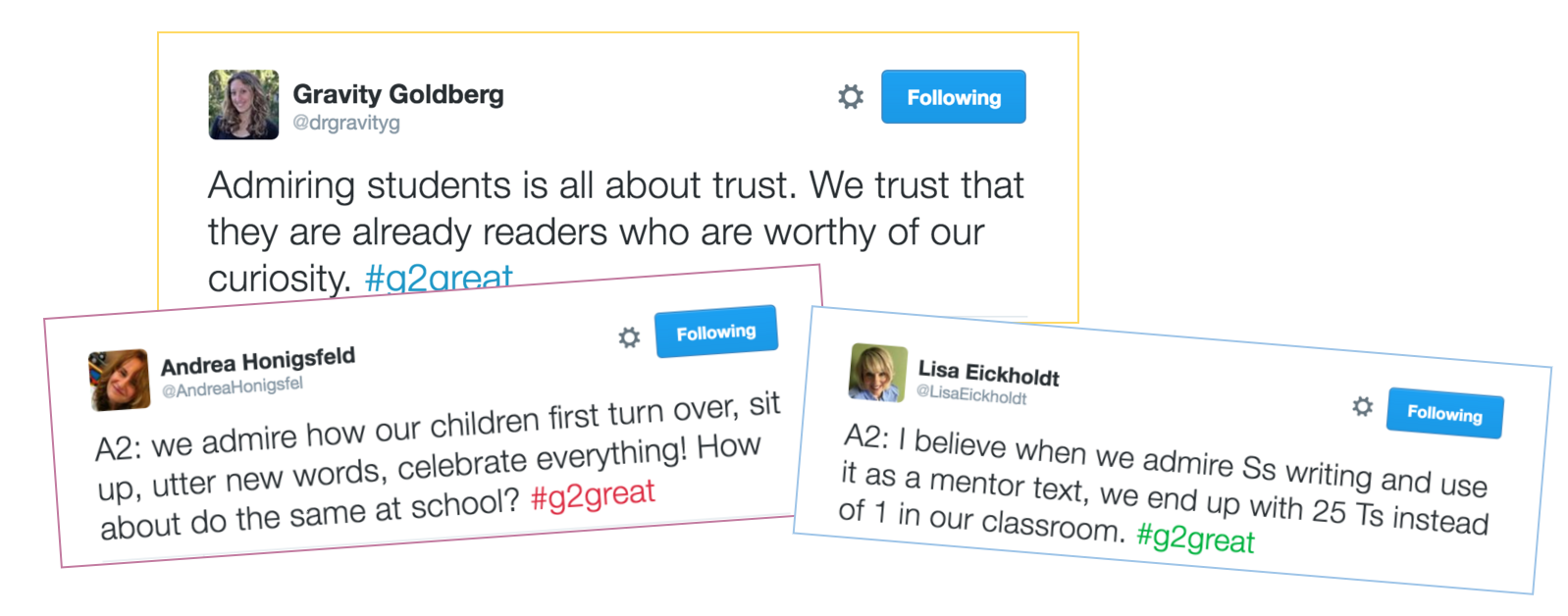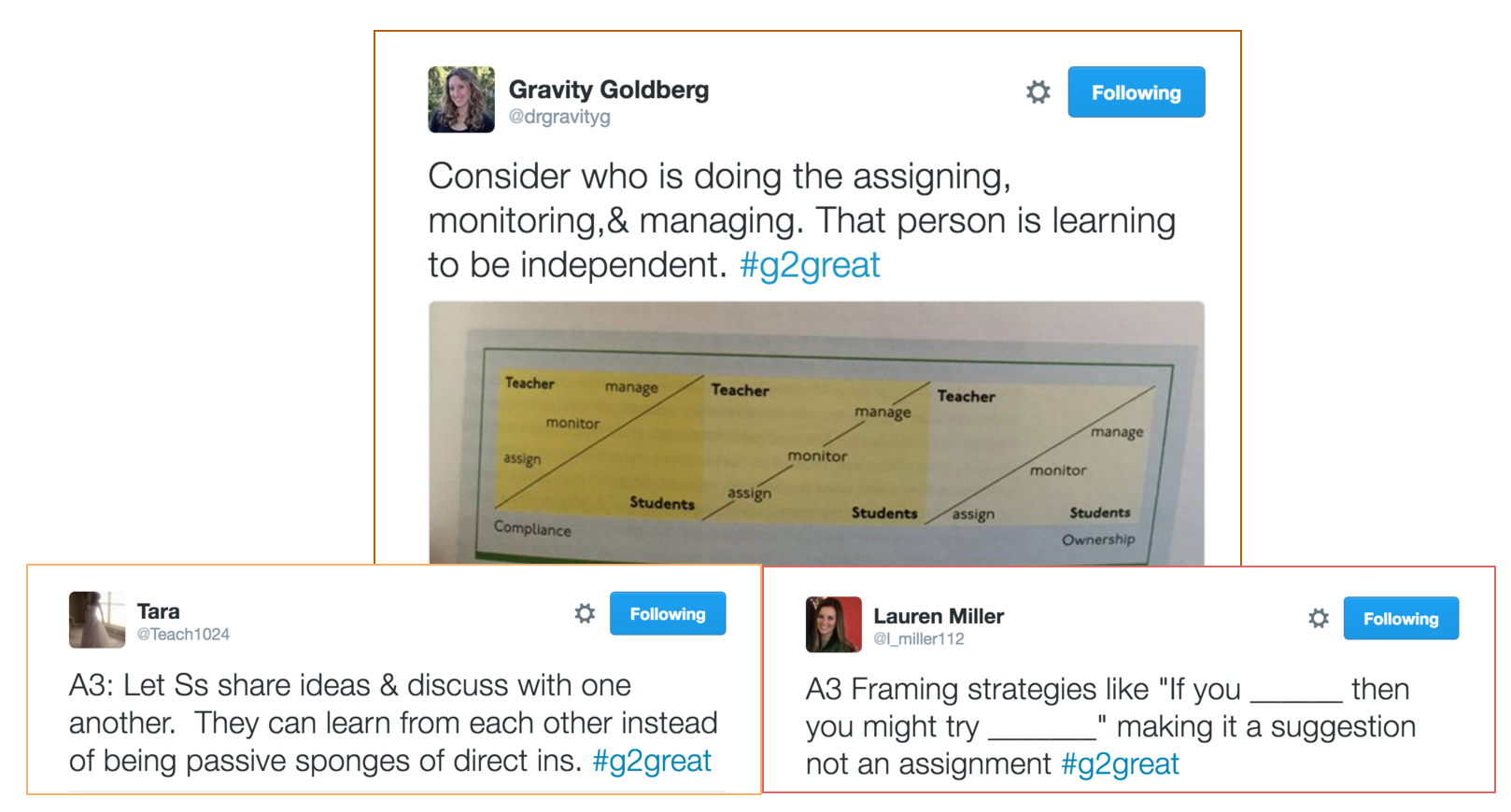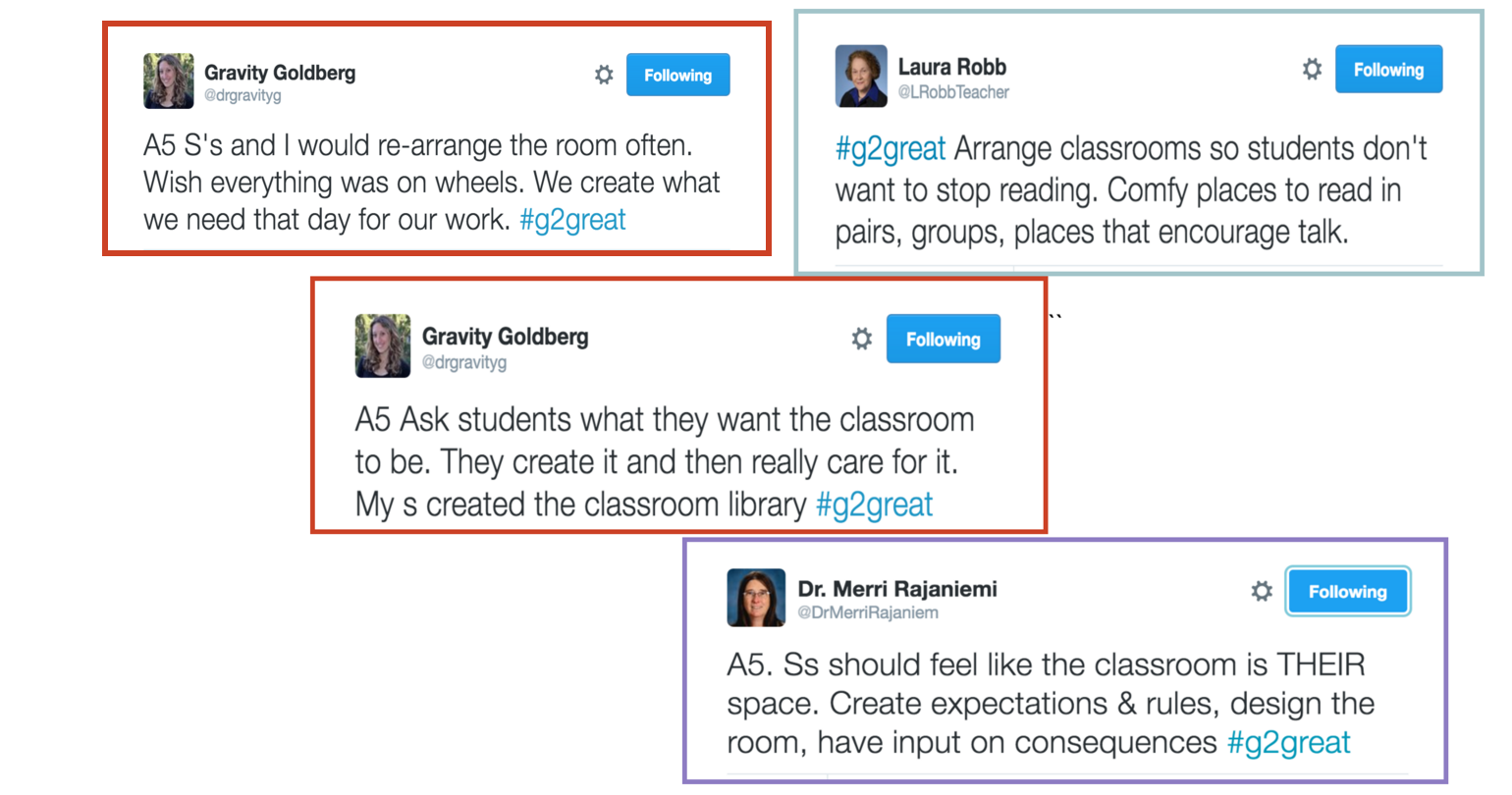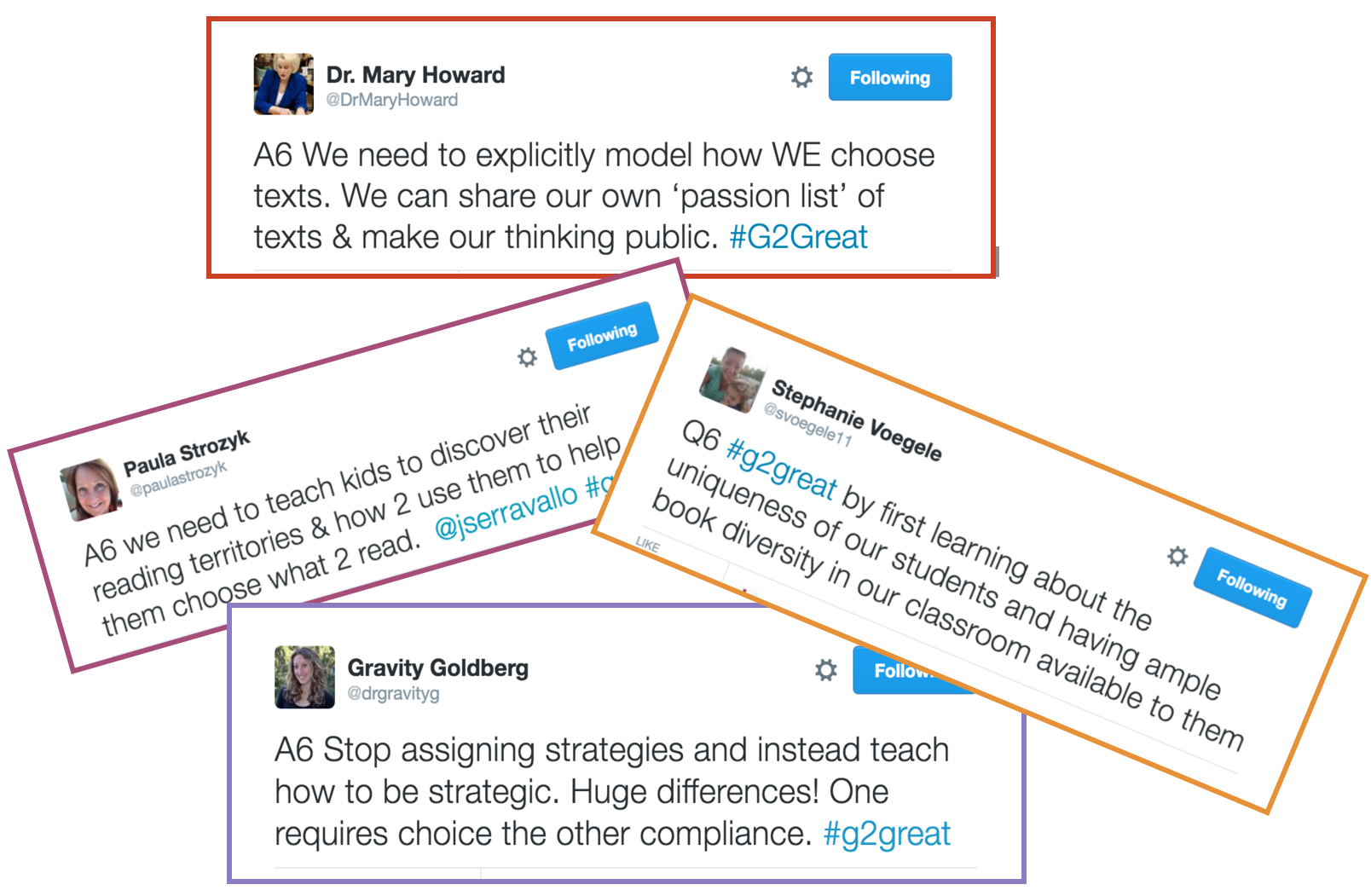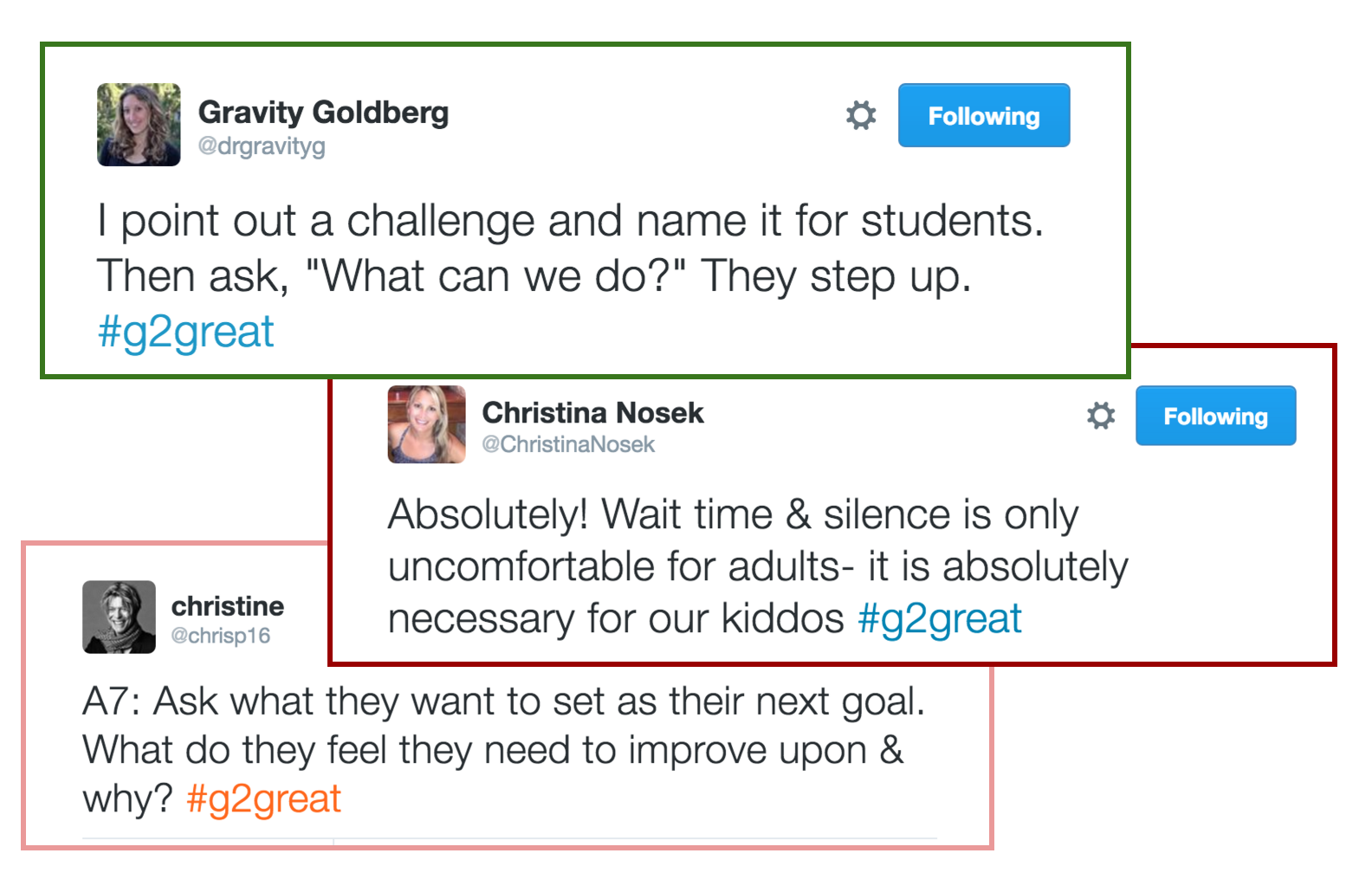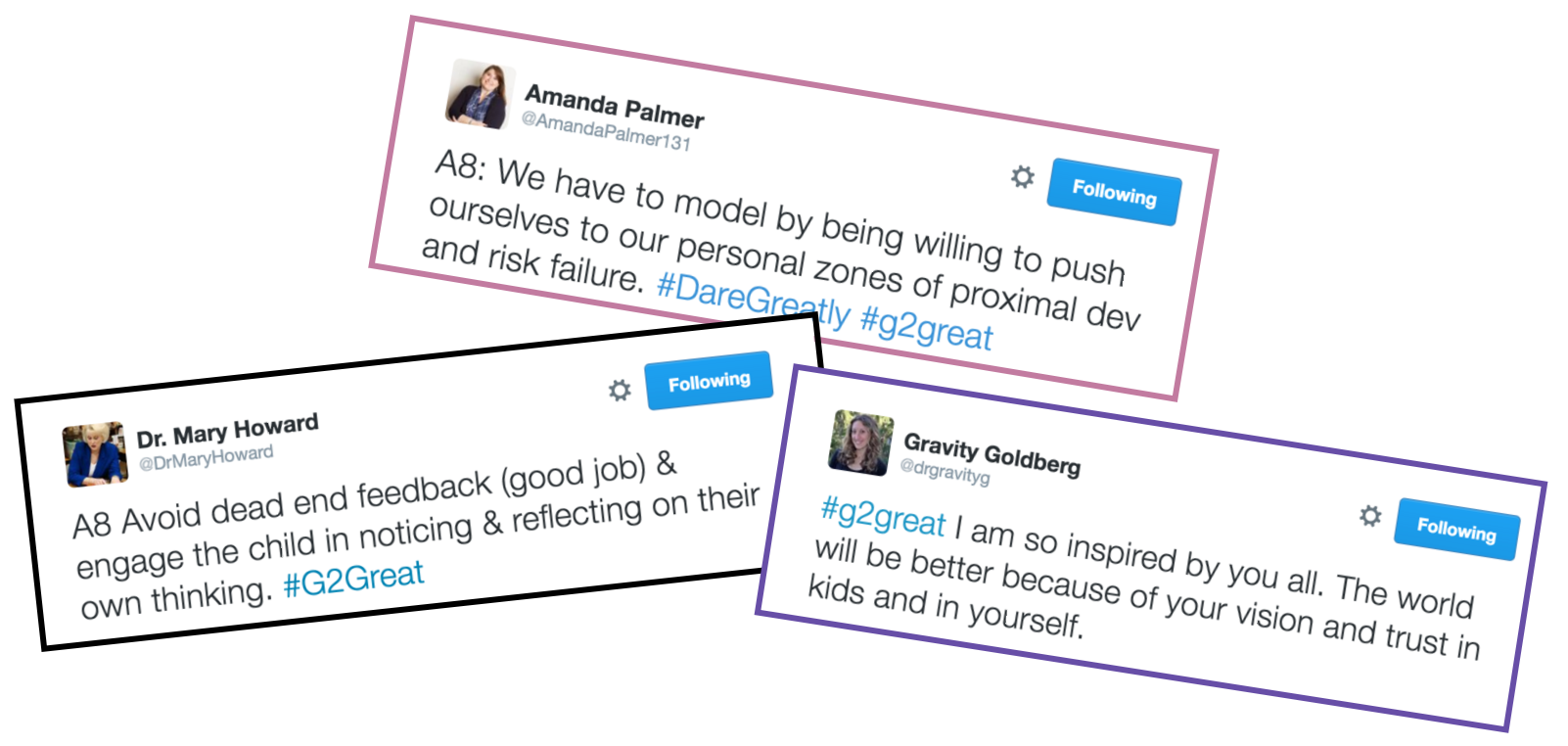
Written by Mary Howard
On 10/20/22, we had the great pleasure to welcome Regie Routman back to our #G2great chat for a renewed look at her incredible book, Literacy Essentials: Engagement, Excellence, and Equity for All Learners (2018, Stenhouse). We first celebrated Regie Routman and Literacy Essentials on a #G2great chat 1/11/18.
It was a conscious choice to honor Literacy Essentials a second time. At the start of 2022, our chat team added a BLAST FROM THE PAST feature. We’ve held weekly chats since 1/18/15 with year eight coming January 2023. As of writing this post, we’ve supported 351 chats with many professional books. In an educational publishing industry in a constant flow of new books, we know that some are still desperately needed regardless of publication date. Our goal is to put important books back on the radar screen to for teachers who missed it when it was published. When we select a book for BLAST FROM THE PAST, we modify quotes and questions so that even teachers who attended the first time can see the book through fresh eyes and renewed perspective while bringing new research supported understandings they gained since it was published.
One quote we shared in both chats speaks volumes about the very heart and soul of Literacy Essentials and why nearly five years after its publication, it remains at the top of my list of MUST-READ books:
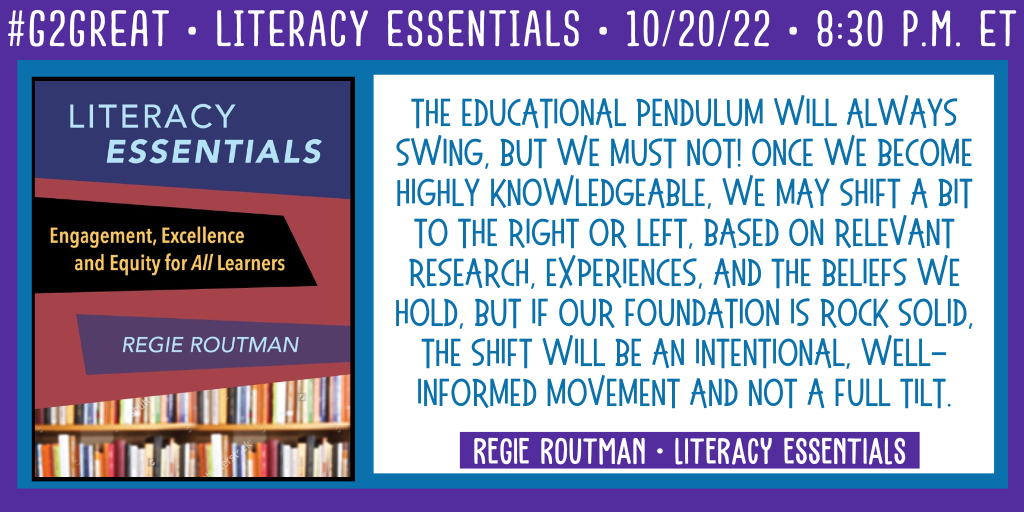
From the publication of her first book, Transitions: From Literature to Literacy in 1988 to Literacy Essentials, Regie Routman’s deep belief in teaching with a sense of urgency and her unwavering respect for how we expend precious minutes has been a central belief in all of her inspired work. Regie writes these words about teaching with a ‘sense of urgency’ in Literacy Essentials:
“Teaching with a sense of urgency means focusing relentlessly on what’s most important throughout every single day, moving at an efficient and effective steady pace, seizing problems and failure as opportunities for growth, and changing course as needed.” Page 55
Regie brings this spirit to life by highlighting three Literacy Essentials including: Engagement, Excellence, Equity. Across the pages of Literacy Essentials, she consistently honors a sense of urgency with every possible detail in repeated sections including, Take Action with ideas for moving forward; Efficiency Tips to fine tune our efforts, and a mesmerizing real-life personal Story at the end of each chapter that inspires and informs our professional lives. (Note: Be sure to check out the links at the bottom. The first two I shared offer free resources for Literacy Essentials. I also suggest perusing the Stenhouse June/July 2019 Literacy Essentials Book Study in an amazing conversation with resources, references and comments from Regie Routman.
Let’s pause for a moment to hear from Regie Routman and her heartwarming response to a question we posed about Literacy Essentials:
What is a message from the heart you would like for every teacher to keep in mind?
These are tough and traumatic times to be teaching, although that has always been true to some extent. What’s most important, I believe, is to lead with empathy and a compassionate heart, to collaborate with colleagues because this job is too complex to do by ourselves, and to be responsive to our students’ strengths, interests, and needs. Think about focusing on these 3 R’s first: relationships, relevance, and resilience–and establishing a classroom and school culture of inclusion, respect, and conversations that matter.
Through prioritizing high expectations, meaningful content, and wide choice in the texts students read and write, we can still bring joy to teaching and learning. None of this is easy, but my hope is that reading and discussing Literacy Essentials will make your teaching/learning/living life more satisfying, engaging, excellent, and equitable for you and your students. Use the detailed Table of Contents with sections to decide where to begin or dig in. I am by your side as fellow learner and teacher. Remember this: you can only do the best you can, and that has to be enough. Uplifting even one life is a huge accomplishment. For that learner, it can be lifechanging. Go easy on yourself, take deep breaths, and savor some moments in the day just for you.
When Regie was on #G2Great on January 11, 2018, I had the great honor to write our post that can be accessed here. Since my focus in that post was on the book, in the remainder of this post I’d like to highlight learning shared on our twitter chat discussion to extend and support my initial blog post and Literacy Essentials
A great place to begin is with Regie Routman’s responses to our #G2Great questions. I’ve included the question followed by her thoughtful response/s:
Q1 Before we begin, let’s reflect on Regie’s challenge to approach our teaching with a “sense of urgency and relentless pursuit of excellence.” How do you make this a daily priority, regardless of roadblocks that may stand in your path?
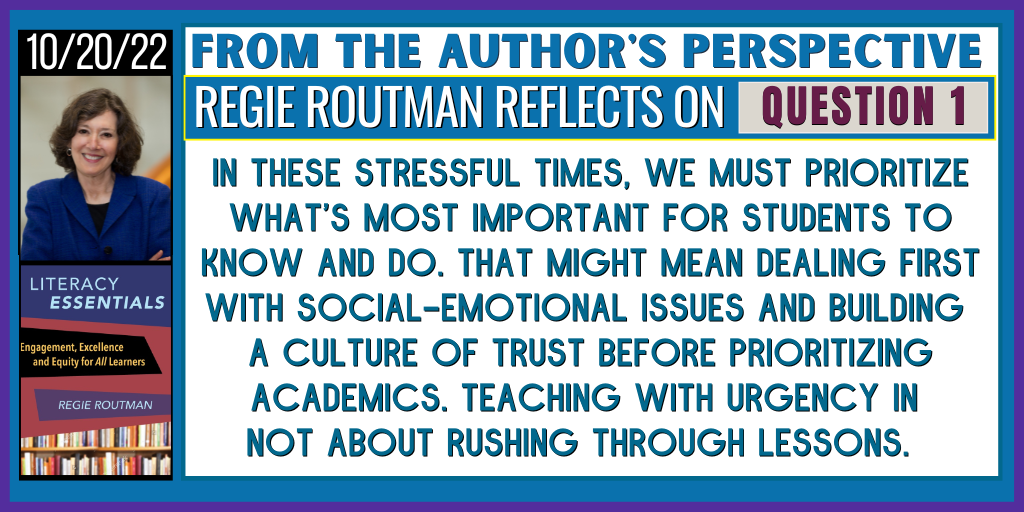
Q2 In her book, Regie draws our attention to three areas that reflect Literacy Essentials for all learners: Engagement, Excellence, and Equity.Why are these essentials more important than ever?
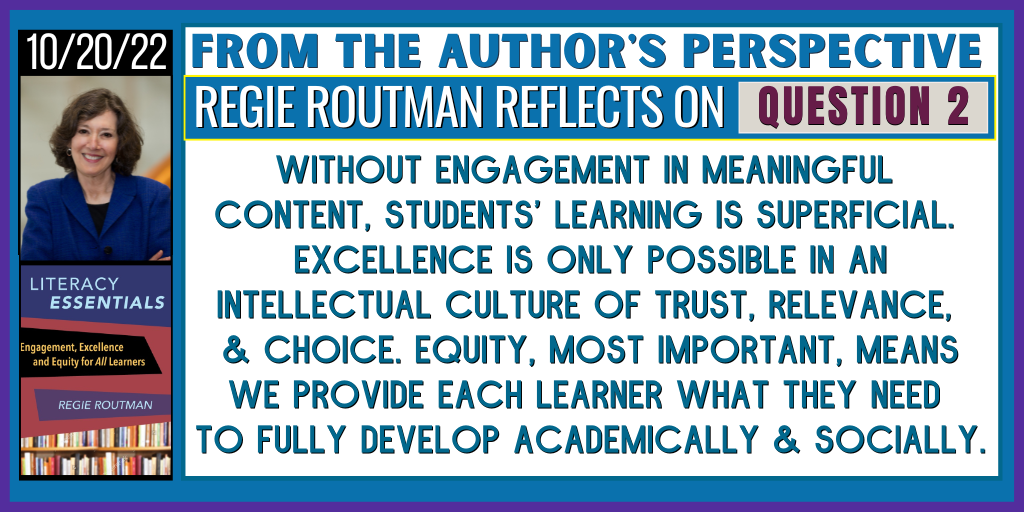
Q3 Regie has long championed the reading-writing connection. How can the reciprocal role of reading and writing elevate our teaching? What is one way that you celebrate this mutual relationship in practice?

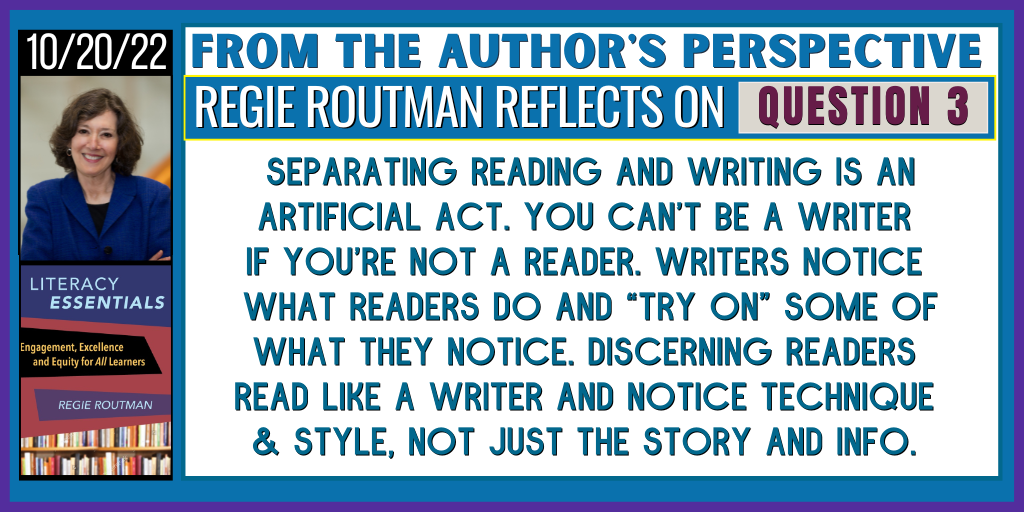
Q4 Regie reminds us that the end goal of teaching reading is to help students ‘BE READERS’ and she emphasizes free choice independent reading as our #1 priority. How do you bring this priority to life within each teaching day?
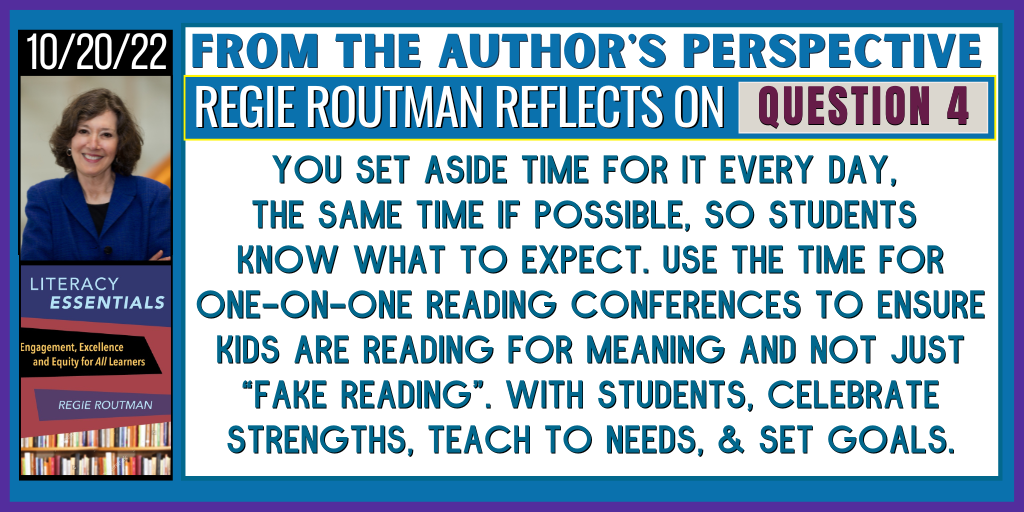
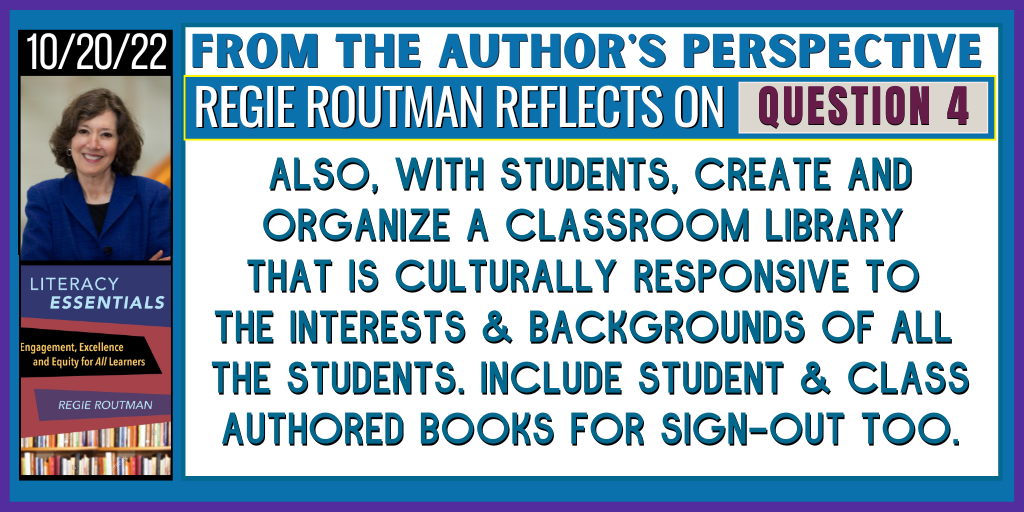
Q5 Regie writes, “Equity means we provide all students equal access to an excellent education— that is, we ensure they receive what they need and desire to reach their full potential.” How are you making this vision a reality?
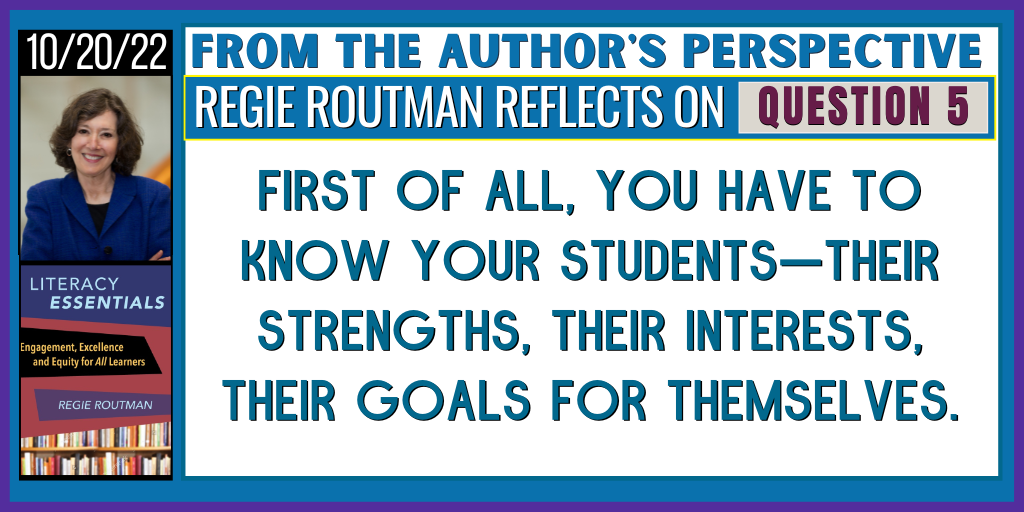
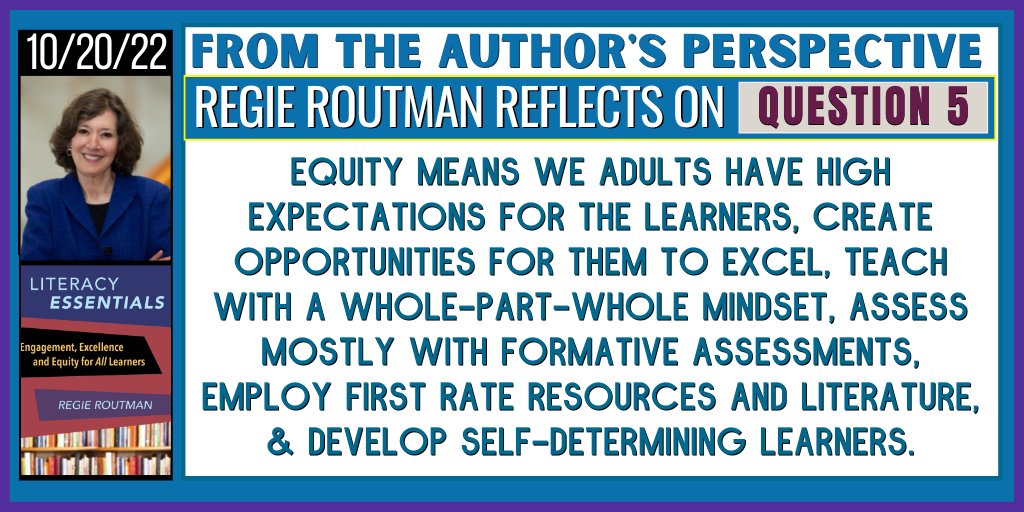
Q6 Regie asks us to focus on “responsible assessment” including formative and self-assessment to ensure that instruction addresses the specific learning needs of children. What are YOUR responsible assessment essentials?

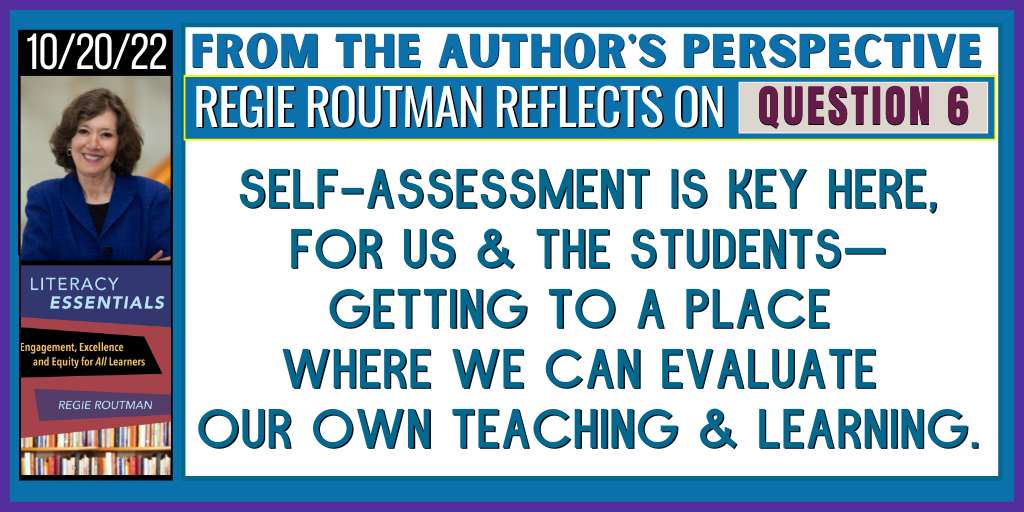

We are very fortunate to have an incredible group of educators who join our weekly chat discussions. These amazing educators added an additional level of thinking for our Literacy Essentials discussion:
ADDITIONAL CHAT TWEETS FROM OUR DISCUSSION
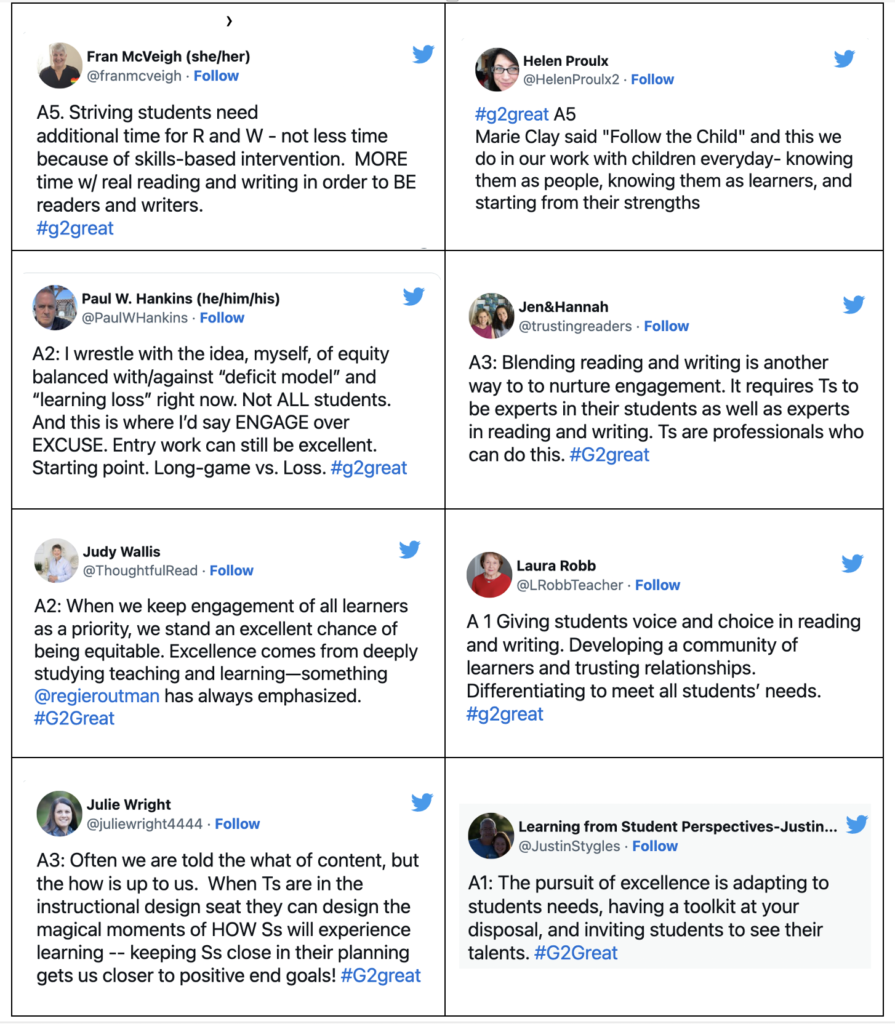
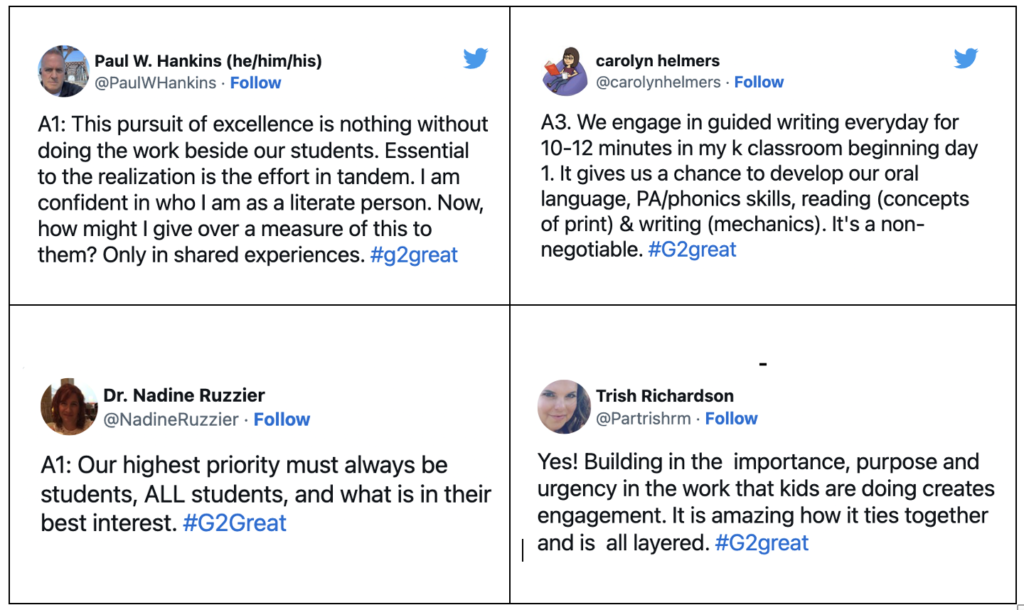
CLOSING THOUGHTS FROM MARY
I’d like to reach back to 2018, the year that Literacy Essentials was published and Regie joined our #G2Great chat for the first time. On August 18, 2018, Regie shared this wonderful tweet that I’ve referred to on many occasions since it speaks volumes about central messages that appear across Literacy Essentials.

One of the beautiful things about having such an important book on our #G2Great chat twice is that it allows us not only to bring Literacy Essentials back into public attention, but also gives us two conversational references that invited old friends and new into the conversation over time in a collective merging of understanding ranging from 2018 to 2022.
Books like Literacy Essentials need to be on a shelf of honored books within easy reach, referenced so often that the pages are dog-eared with highlighting and pencil jots from cover to cover. I’m a long-time advocate for re-reading one or two books each year that spoke to me in the past. That is the intent of our Blast from the Past chat and I can’t think of a better book to reach for virtually or face-to-face.
In her introduction, Regie writes a “Letter to my colleagues” and she poses a question that is pertinent to all of us, especially in such a challenging time in our history:
“How do we rise to the challenge of providing an engaging, excellent, equitable education for all learners—including those from high-poverty, underserved schools? In spite of all the obstacles we face—politically, professionally, personally—we teachers matter more than ever.” Page 1
There is no doubt in my mind that the answer to that question is to read Literacy Essentials from cover to cover, refer to it often and keep it lovingly perched on a shelf of honor for easy access.
On a very personal note, I would like to express my deep gratitude to Regie Routman; for long-time dedication to this profession, teachers everywhere who put her words into action and the children who are at the center of all she does. I will forever hold dear your message and I’m so honored to call you dear friend. With much love and deep appreciation!
Mary
LINKS
Literacy Essentials at https://www.stenhouse.com/literacyessentials (includes book excerpts from each of the 3 sections of the book, a video walk-through of the whole book, a Study Guide, and several podcasts; one “podcast” and Stories, personal and professional, that are woven throughout the book. (Highly recommended)
Literacy Essentials Stenhouse website (more free resources including hundreds of professional articles and some videos, all related to the book’s content, that are hyperlinked for reading, viewing, and downloading for study and discussion. There is also a comprehensive, extensive lesson plan and downloadable samples of class authored books.
#G2Great chat with Regie Routman on 1/11/18 for Literacy Essentials: Engagement, Excellence and Equity
#G2Great Wakelet artifact from our 1/11/18 #g2great chat with Regie Routman
ORDER HERE: Literacy Essentials: Engagement, Excellence, and Equity for All Learners (2018, Stenhouse)
Literacy Essentials Stenhouse Literacy Essentials Book Study (June/July 2019)
A generous list of Podcasts compiled by Regie Routman
Three-part podcast with Jacob Chastain: Equity with Regie Routman
‘Roaming Around the Known’ with an Adult Learner by Regie Routman
Regie Routman on What’s Essential Right Now in Education with Matt Renwick

